|
Return to the River |

|
|
By Milton "Skip" Johnson - Houston, Texas - USA |
Last years attempt
at the Colorado 100 river race had been a grand adventure
along with a lot of learning experience about down
and dirty boat building. Chuck had opted out of paddling
in the race again this year due to other commitments.
At least the commitments were properly prioritized,
Water
tribe Challenge, float down the San
Juan, various messabouts. I was going
to paddle solo. A new boat was in order.
Construction is going to be a little more mainstream,
but still a light sit-on-top 17-18’ loa a lot
like the Bionic
Log with a rudder and better ergonomics
(higher seating). I’ve got a knee high stack
of ½” 3# klegecell, bought 20 years ago,
leftovers from a 65’ trimaran built down on
Bolivar peninsula ($6.00/ 32”x48” sheet).
And, there is that roll of 17 oz biaxial e-glass I’ve
stored for my son for 10-12 years. That’s most
of the makings of a new boat, along with leftover
epoxy and other almost scrap. Just need to find the
time to design, build and train.
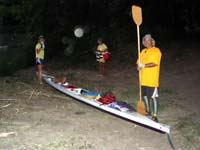 |
Sue, Susie
and I ready for the dawn start of the
CR100
(click
images to enlarge) |
|
While all these pieces were running around in my
head early in the month of May, Sue Van Natta, my
long term aerobics instructor at the Y expressed an
interest in paddling with me one of these days. I
told her about the Colorado 100 and gave her the web
links to official site and articles on Duckworks.
A few days later she told me she really wanted to
do it but needed to think and pray on it and get an
OK from her family if it was a go. I told her to take
her time but decide by June 1 for early registration.
Actually June 10th was cutoff for early registration,
but I was going to be out of the country then.
I’ve known Sue for a long time. Susie and I
used to babysit and change the diapers on her twin
girls who are going to graduate from high school next
year. I’m not sure Sue has ever even been in
a boat before but she has finished a lot of marathons
for the Leukemia Society and just finished her first
triathlon. Underneath that perky pleasant demeanor
probably lurks the heart and soul of a competitor.
I may be in trouble.
Sue said yes, so I’m going to paddle tandem
adventure class again. That’s adventure class,
Sue, please remember, adventure class.
A new boat design is in order and it needs to be
done quickly so we’ll have some time to train
before the (adventure) race. This time the boat will
have a name. Sue and I have kidded each other for
years about how in our respective venues bystanders
will encourage the runners or paddlers by saying they
are “almost there” when in fact there
are several miles to go. Almost There will be paddled
by the beauty and the beast, one of us is a cute,
perky very fit redhead and the other is old, heavy
and hairy (except for the bald part).
Based on the previous nameless boat, twenty-four
feet long is about right. Any longer and the added
surface area starts to be a drag, literally. Any less
and wave making starts to be significant, even in
deeper waters, such as they are. The shape is almost
the same, just a touch narrower, slightly higher prismatic
coefficient and a flatter fuller section toward the
stern to take a little edge off of the shallow water
drag.
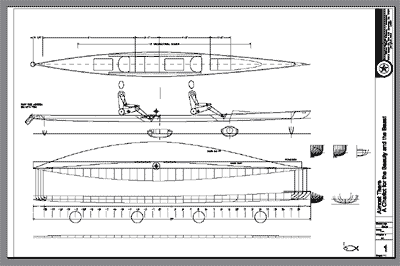
click image to view PDF drawing
This time I spent a little more time actually calculating
moments since I’d messed up previously and there
is even more mismatch in paddlers weight this time.
I weigh half again as much as Sue so she needs to
have her center of gravity half again as far from
the center of buoyancy as yours truly. When this was
all doodled out, my foot well position was right at
the midsection of the boat which meant that with a
little connecting tunnel between footwells a single
pump could do the job of keeping our feet dry most
of the time. In theory a 500 GPH bilge pump could
drain both footwells completely in just over a minute.
Assuming they were completely flooded.
Basic rudder configuration had done a very good job
previously and courtesy of Duckworks I had a set of
new whizbang adjustable
footrest/rudder pedals made by SeaDog
that will let you move the pedals over a 9-1/2”
range without fiddling with the cable connections.
Still seems a little spooky, reminds me of quantum
theory and action at a distance, but I’ve seen
other similar adjustable pedals since. Rather than
spectra rudder cables this one will use nylon coated
stainless steel fishing leader run in bicycle shifter
cable housing.
A few comments and graphs (derived from Mitchlet)
follow for those that are interested in the fiddly
details of drag.
First, the drag curves for EasyB
(12’), Preliminary Solo C100 (18’) and
Almost There (24’- drag for one paddler). These
curves are for a water depth of 0.5 meters and graphically
show the influence of length and water depth. Drag
is in kilonewtons and the speed range is from 1.0
meter/second to 4.0 meters/second in 0.1 meter/second
intervals. Take some of this data with a grain of
salt. I know from experience EasyB will be significantly
easier to paddle in the lower speed ranges (1-5),
the rest however is dead on. Two things are obvious.
First, for speed, longer is better. Second, shallow
water sucks, literally and figuratively. The hump
in the graph at about 13 is strictly due to the added
drag from being in shallow water. It’s also
pretty obvious I lucked out when Sue wanted to paddle
in the race. Whether it is going faster for the same
effort or just being easier to paddle at any given
speed, tandem is better than solo from a drag standpoint.
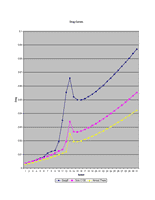 |
Drag curves
A - click for PDF version
|
|
Then take a look at the second graph and some of
the really obscure details of drag in shallow water.
In this case for a water depth of 1.0 meters (the
hump is shifted to the right).
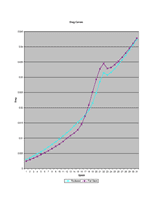 |
Drag curves
B - click for PDF version |
|
These are both versions of Almost There with a slight
change in the after sections. The rockered hull has
virtually equal rocker fore and aft for minimum wetted
surface area. The flat stern hull is identical except
most of the rocker is taken out of the stern sections.
For some reason the fullness in the stern takes a
little of the edge off of the drag at the shallow
water hump but adds a little extra surface area which
adds drag in the slower speed ranges. Alas, still
no such thing as a free lunch. In this case, with
a sneaking suspicion that my new partner will be setting
a pace that will put us in the higher ranges, Almost
There will have the flatter, fuller stern sections.
Finally, I’ve included a couple of images of
the wave patterns behind the boat in one meter deep
water and two meter deep water.
 |
One meter
wave pattern
(click
for larger view)
|
|
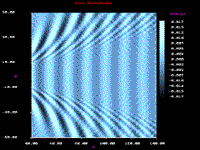 |
Two meter
wave pattern
(click
for larger view)
|
|
Skip

Other Articles by Skip Johnson:
|